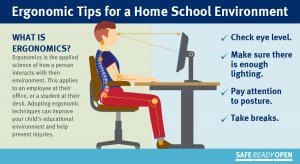As our world becomes increasingly more digital, people are spending more time sitting on computers than at any point in human history. Anyone who has sat in the same place typing away or browsing the internet for more than a few hours knows how uncomfortable it can be. People who sit at desks for a living are certainly familiar with the term ‘ergonomics’, but often people overlook the importance of proper posture and a proper desk setup. The media plays an important role in conveying this valuable information. It can be difficult for people to sort out what is valid information versus what is click-bait. I had a chance to review three articles that one would discover when looking for information on the topic. Hopefully after reading my blog you will be more informed to make a decision whether to click that article or not because I have got your back.
True or False?
A WebMD article, Ergonomic Tips for a Home Office shows on the first slide that if an individual has arthritis, they have an increased need for ergonomics.
The article Ergonomic intervention for employed persons with rheumatic conditions talks about the study of ergonomics and how involving these techniques while at work can reduce discomfort and prevent injury. Jobs that involve computers are on the rise and individuals with arthritis choose desk jobs because they are less physically demanding. Evidence shows that people who have arthritis have a hard time using computers. The Ergonomic Assessment Tool for Arthritis is an assessment is used to find ergonomic interventions for individuals with arthritis. Evidence suggests there are positive effects for using ergonomics to decrease limitations at the workplace (Mann, Singh & Singh, 2013). True !
True or False?
A WebMD article, Ergonomic Tips for a Home Office shows on the first slide that if an individual has arthritis, they have a need for ergonomics.
The article Ergonomic intervention for employed persons with rheumatic conditions talks about the study of ergonomics and how involving these techniques while at work can reduce discomfort and prevent injury. Jobs that involve computers are on the rise and individuals with arthritis choose desk jobs because they are less physically demanding. Evidence shows that people who have arthritis have a hard time using computers. The Ergonomic Assessment Tool for Arthritis is an assessment is used to find ergonomic interventions for individuals with arthritis. Evidence suggests there are positive effects for using ergonomics to decrease limitations at the workplace (Mann, Singh & Singh, 2013). True !
True or False?
Problems and conditions associated with desk work relates to muscle pain.
Without a place to put your elbows, your neck and upper back muscles will have to work harder to support the weight of your arms, and you’ll also apply more pressure to your wrists while using a keyboard and mouse.” (Cook, 2021, p. 1) True !

This picture explains why ergonomics is important and how we can use this tips at work, school or home!
This is one medical intervention that seems to hold true. I hope you learned a little more about ergonomics and consider using it while you are sitting at your desk.
References:
Allaire, S. J., Backman, C. L., AlHeresh, R., & Baker, N. A. (2013). Ergonomic intervention for employed persons with rheumatic conditions. Work, 46(3), 355–361. https://doi.org/10.3233/wor-131761
Cook, J. (2021, February 10). Set up an ergonomic home office before you destroy your body. Popular Science. Retrieved February 13, 2021, from https://www.popsci.com/story/di y/ergonomic-home-office-setup/
Mann, R., Singh, A., Singh, M., & Singh, J. (2013). Combined effects of Stretching and Ergonomic Advice in Computer Professionals on the Incidence of Upper Limb Disorders. Indian Journal of Physiotherapy and Occupational Therapy – An International Journal, 7(4), 186. https://doi.org/10.5958/j.0973-5674.7.4.146
Thomasnet. Budget-friendly, Effective Ergonomic Interventions for Industrial Workplaces. Thomasnet® – Product Sourcing and Supplier Discovery Platform – Find North American Manufacturers, Suppliers and Industrial Companies. https://www.thomasnet.com/insights/budget-friendly-effective-ergonomic-interventions- for-industrial-workplaces/.
Van Niekerk, S. M., Louw, Q. A., & Hillier, S. (2012). The effectiveness of a chair intervention in the workplace to reduce musculoskeletal symptoms. A systematic review. BMC musculoskeletal disorders, 13, 145. https://doi.org/10.1186/1471-2474-13-145
WebMD. (2020, May 2). Ergonomic Tips for a Home Office.
WebMD. https://www.webm d.com/pain-management/ss/slides how-ergonomic-tips-for-a-home-office.

This was a great and informative posting that tackles a real world issue. Ergonomics in my opinion are under looked and its something that can make a difference in life. Most people are unaware of proper body mechanics and this leads to body aches and long term issues. The post you provided was very well organized and informative. I liked the visual you provided about proper placement of the computer screen and body positioning. This is something that can be used by mostly all of the working population and a great topic you chose.